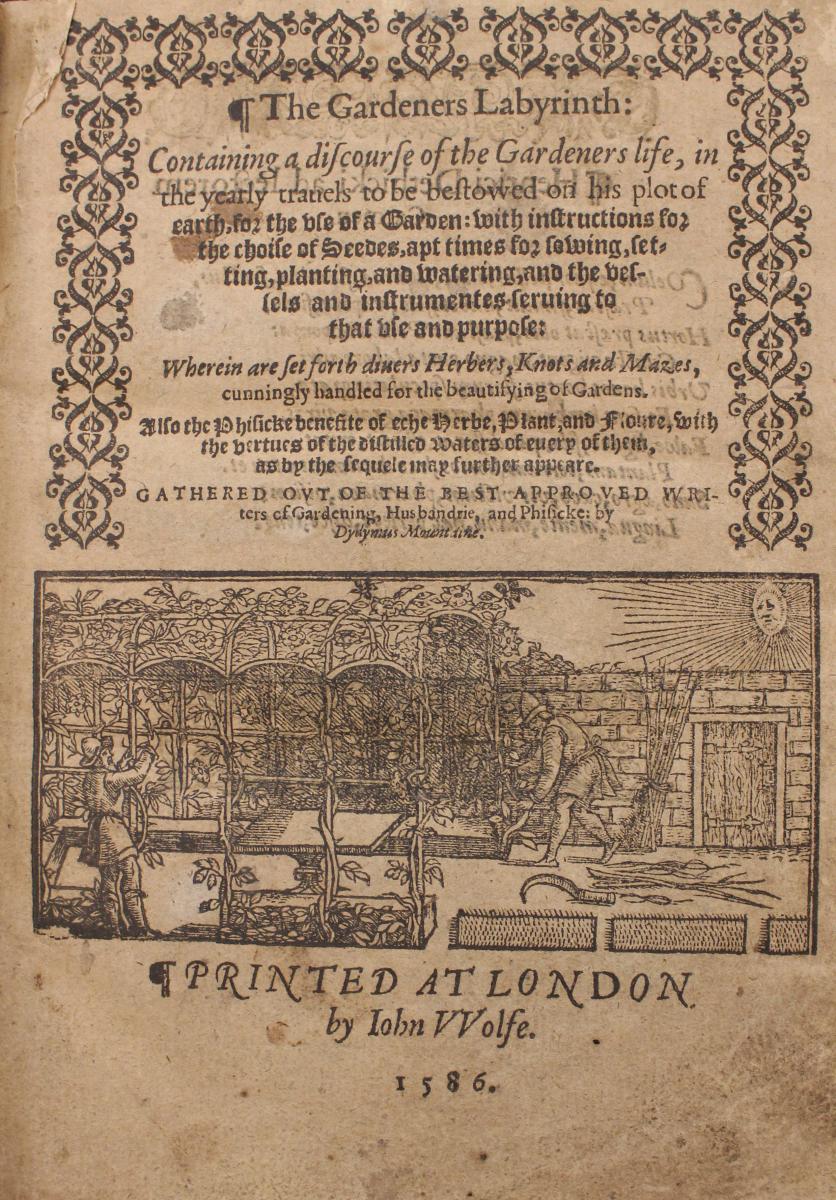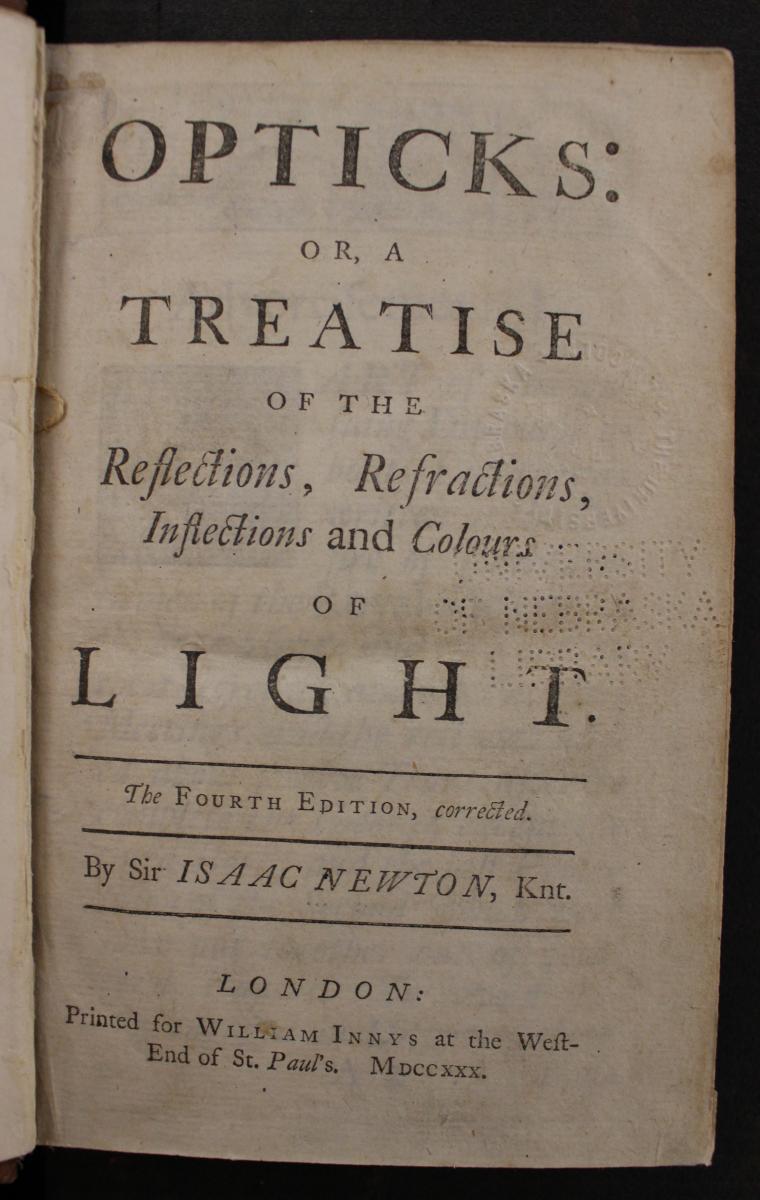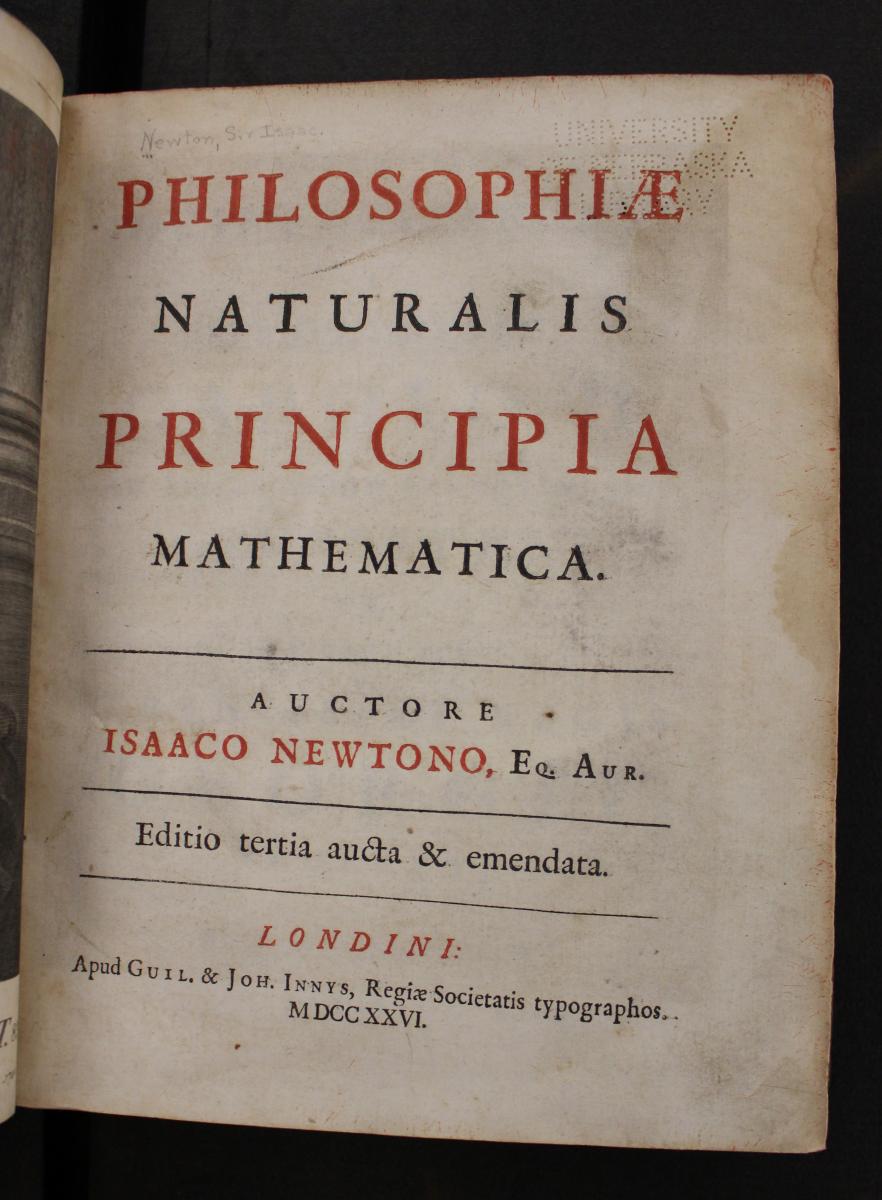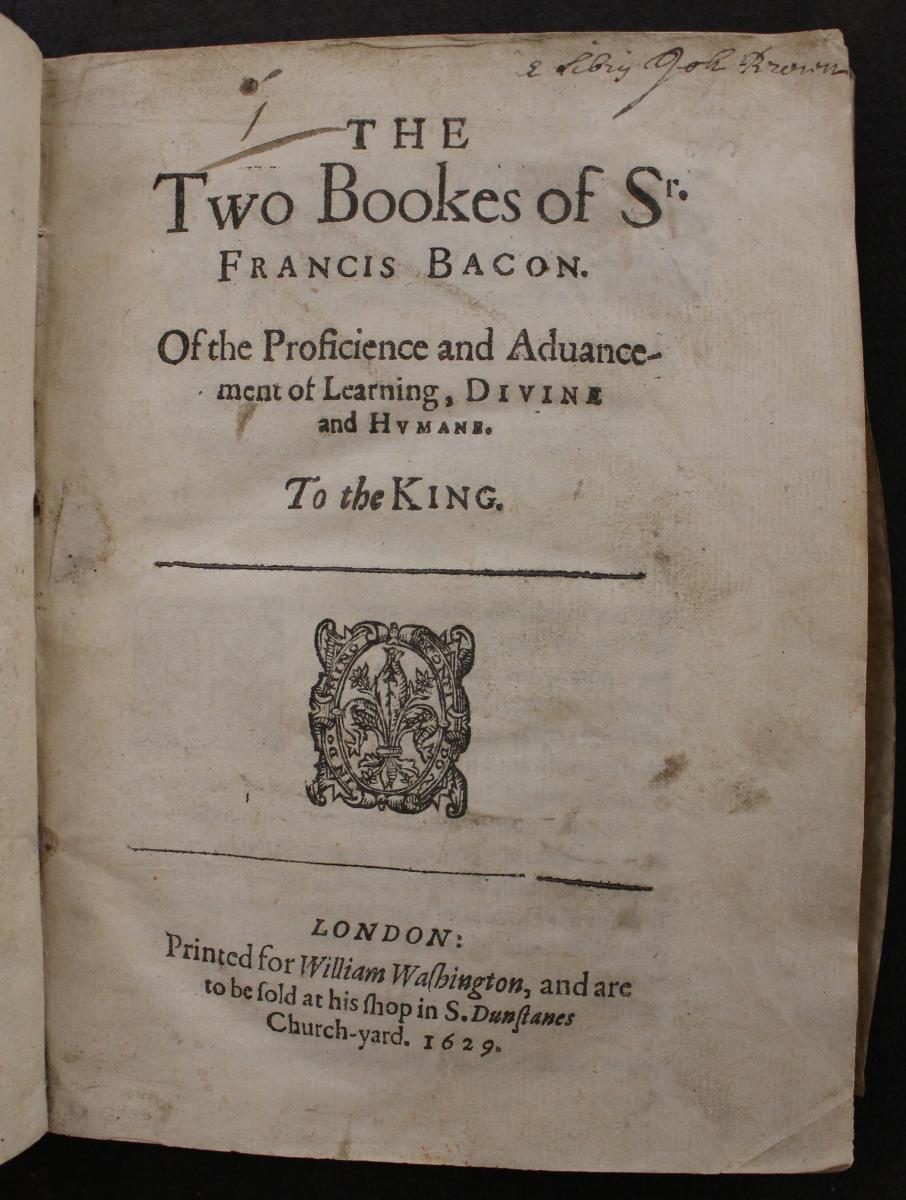The Natural World and Natural Philosophy
While the roots of science and medicine extend back into the ancient and classical world, in the medieval era it became known as natural philosophy, due to Aristotle's heavy influence during that era. The Scientific Revolution began in 1543 with the publication of Copernicus' De Revolutionibus and Vesalius' On the Workings of the Human Body, with further advancements made in the coming centuries by Galileo, Robert Hooke, Brahe, Kepler, Pascal, Edmond Halley, Sir Francis Bacon, Sir Thomas Browne, Rene Descartes, and Thomas Hobbes.The terms "scientist" and "science" didn't really develop until the nineteenth century, as many areas of study became professionalized and split into various branches, such as zoology, biology, physics, etc.
Author: unknown
Hortus sanitatis [maior]
Other title: The Garden of Health
Argentorati: per Mathiam Apiarium, 1536
Note: In box, bound in full gold-tooled calf by Thomas Berthelet (d.1555)
Adoption Price: $100
ADOPTED!
Author: Konrad Gesner (1516-1565)
A new book of distillation of waters : called the Treasure of Euonymus, …
Other Title: Treasure of Euonymus
London : by John Day ..., [the fyrst of June, 1565]
Note: title page inscribed "Thomas Garrard, gentleman" [Sheriff of Lancashire, b. c.1511, d. c.1560/71; or his son Sir Thomas Gerard, b.1530; or Thomas Garrard of London (d.1632) who was Sheriff] and other inscriptions; p. [16] (3rd grouping) inscribed "Dr Thomas Fanshaw"
Adoption Price: $100
Author: Nicholas Culpeper (1616-1654)
Pharmacopœia Londinensis, or, The London dispensatory: further adorned by the studies and collections of the Fellows now living, of the said College ...
London : Printed by John Streater, 1667
Note: Culpeper was a famous herbalist, botanist, and physician in 17th century England, and he published his work in an effort to educate lay persons better about health. His work had a significant impact on medicine in the English colonies, even extending into modern medicine.
Adoption Price: $100
ADOPTED!
Author: John Parkinson (1567-1650)
Theatrum botanicum: the theater of plants, Or, An herball of a large extent.
London, Printed by T. Cotes, 1640.
Adoption Price: $100
Author: Galen
On the therapeutic method. Book 3-6. English.
Other Title: Certain works of Galens, called Methodus medendi
London: Printed by Thomas East ..., 1586.
Note: Leaves 136-138 missing; leavings [1], [3]-[4] (1st grouping) and 134 repaired; marginalia in pencil or brown ink on title page and numerous pages of text
Adoption Price: $100
Author: Gerhard Mercator (1512-1594)
Atlas minor
Amsterdam: Ioannis Ianssoni, 1634
Adoption Price: $250

Author: Thomas Hill (born c. 1528)
The gardeners labyrinth
London: Printed by John Wolfe , 1586.
Note: first book printed in English on gardening.
Adoption Price: $100
ADOPTED!
Author: Gervase Markham (1568?-1637)
The English Husbandman, drawn into two books, and each book into two parts
London, Printed for Henry Taunton, 1635.
Description: Gervase Markham was the third son of Robert Markham from Nottinghamshire, of the country gentry class. He was educated, and associated with the radical Protestant nobility, especially Essex, for whom he wrote propaganda poems. He probably served in the army in Ireland for a while. He is best known as a prolific writer, who wrote for money and sometimes recycled what he had written. When Essex fell, Markham retreated to the countryside and occupied himself in farming for a period. Markham wrote what are regarded as mediocre poems, and also guides to all kinds of practical skills. He was especially passionate about equestrianism, and wrote so many books on this subject with so much recycled text that he was forced to sign a unique agreement with his publishers never again to write about horses. This is a remarkable textbook on how to be a farmer in early seventeenth century England. It is a very rich trove of material culture lore. This book is about 7 1/2” x 5 1/2” x 1 1/4” thick, and bound in brown leather. It’s spine is divided into six sections by ruling, with no ridges. There is double groove square framing on the front and back cover, but no stamp marks inside this. The inside cover and separating leaf are covered with an olive green paper. There is only one blank separating leaf rather than two as in three of the other books. It has a University of Nebraska Library sticker inside the front cover. The printer’s notice is: “London. Printed for Henry Tounton, and are to be sold at his shop in Saint Dunstan’s Church-yard in Fleetstreet. 1635”. There is a title page, and a dedication to James Stuart, followed by a preface “To the general reader”, and a Table of Contents. The book is divided into two Parts. The first part covers “Husbandly duties, the nature of soils in this kingdom, tillage, ploughs, etc.” The second continues with “Art of planting, grafting and gardening, use of the vine, the hopsgarden, preservation of fruits, the draught of all sorts of knots, mazes & other Ornaments”. At the top of the text are italicized page headers identifying the book. The part number, as “Part I”, appears on the inside upper corner, and the page number on the outside upper corner. At the lower right is the leading word of the next page. At the bottom center is a capital letter and a number. It contains marginal references, and proper names in italics. It includes many fine line drawings and diagrams. -- Rory Larson
Adoption Price: $25
ADOPTED!
Author: Robert Burton (1577-1640)
The Anatomy of Melancholy: what it is, with all the kinds, causes, symptoms, prognostics, and several cures of it : in three main partitions, with their several sections, members, and subsections / philosophically, medicinally, historically, opened and cut up by Democritus Junior; with a satirical preface, conducing to the following discourse
Oxford : Printed by John Lichfield and James Short, for Henry Cripps, ao. Dom. 1624
Description: Robert Burton was an English scholar at Oxford, as well as the church holder of St. Thomas the Martyr in Oxford and Seagrave in Leicestershire. Burton’s study looked at a large scope of ideas, but almost all of them led back to his concept of melancholy. He is supposed to have dabbled in astrology at various points in his life, as well as mathematics. Some say that he hanged himself in his chamber at Christ Church in 1640 to fulfill his own predictions, but it is more likely that he lost his battle with depression.
The English style of the book is seemly transitional. It is half way between the modern vernacular and early modern script. There are some of s’s that look like f’s. The work itself is supposed to be a medical textbook covering the subject of melancholy, done in an academic manner. The key word being “supposed,” as the book reads more like literature than science. Furthermore, the text covers more than the subject of melancholy, with topics coming up like the geography of America and such. The book does show signs of ownership. Several different names are signed into the back of the book. There are several indications of marginalia present throughout the book. The previous owners indicated certain important passages by either writing in the margins, making hands pointing with a finger, or making dashes in-between lines. At first glance, the fingers look like numbers, but the consistent image of them points to being a symbol of indication. Several fingerprints made by ink are also seeable at various pages.
The 573-page folio is made with very light parchment, bound in a well-kept fashion. There is little evidence of wear and tear in this book nor is there lots of moisture damage. The book is relatively 8 by 15 inches, making it around the standard size of what a book is considered.
-- Andrew SingletonAdoption Price: $25
ADOPTED!
Author: Francis Bacon (1561-1628)
Novum Organum Scientiarum
Amsterdam: Johannes van Ravesteyn, 1660
Adoption Price: $250
Author: Francis Bacon (1561-1626)
Of the Advancement and Proficiency of Learning, or, The partitions of sciences, IX books, written in Latin by Lord Francis Bacon; interpreted by Gilbert Wats
Oxford : Printed by Leon. Lichfield for Rob. Young & Ed. Forrest, 1640
Adoption Price: $100
Author: William Gibson (1680?-1750)
The farrier's new guide. Containing, first, the anatomy of a horse, being an exact and compendious description of all his parts, with their actions and uses; illustrated with figures curiously engraved on copperplates. Secondly, an account of all the diseases incident to horses, with their signs, causes, and method of cure ... The whole interspersed with many curious and useful observations concerning feeding and exercise ..
London, Printed for J. Osborn and T. Longman, 1727
Adoption Price: $25
ADOPTED!
Author: Mr. Pierre Dionis (d.1718)
The anatomy of humane bodies : improved, according to the circulation of the blood, and all the modern discoveries : publicly demonstrated at the theater in the Royal Garden at Paris / by Monsieur Dionis, Chief Surgeon to the late Dauphiness and to the present Duchess of Burgundy ; translated from the third edition, corrected and enlarged by the author
London : Printed for R. Bonwicke [and 9 others], 1716
Adoption Price: $25
ADOPTED!

Author: Farghānī (active 861)
Alfragani astronomorum peritissimi compendium, id omne quod ad Astronomica rudimenta spectat cõplectens, Joanne Hispalensi interprete, Nunc primùm peruetusto exemplari consulto, multis locis castigatius redditum
Other title: Astronomer's Learned Compendium
Paris: Ex officina Christiani wecheli, M. D. XLVI (1546)
Adoption Price: $50
ADOPTED!
Author: Isaac Newton (1642-1727)
Optice: sive, de reflexionibus, refractionibus, inflexionibus & coloribus lucis : libri tres [book 3]
Other title: Opticks: Or, a Treatise of the Reflexions, Refractions, Inflexions and Colours of Light
This is the scholarly Latin edition by Samuel Clarke after the first 1704 edition in English
London: Impensis Sam. Smith & Benj. Walford, [1706]
Adoption Price: $250

Author: Isaac Newton (1642-1727)
Philosophiæ naturalis principia mathematica
Other Title: Principia
London: apud Guil. & Joh. Innys, 1726
Note: Autograph of G. M. Baker on fly leaf
Adoption Price: $250
Author: Rene Descartes (1596-1650)
Renati Descartes Meditationes de prima philosophia, : in quibus Dei exsistentia, & animæ humanæ a corpore distinctio, demonstrantur
Other title: Meditations on First Philosophy
Amsterdam: Apud Iohannem Blaev, 1644
Adoption Price: $250

Author: Francis Bacon (1561-1626)
The two bookes of Sr. Francis Bacon : of the proficience and aduancement of learning, divine and hvmane
London : Printed for William Washington, and are to be sold at his shop ..., 1629
Note: Limp-bound in vellum; remnant of tie on front cover; bookplate of John Harvey on front paste-down endpaper; spine title, inscribed in ink: "Learning - Bacon". Also on the title page, there is inscribed: "E[x] libris Joh Brown" along with marginalia in pencil on many pages.
Adoption Price: $500